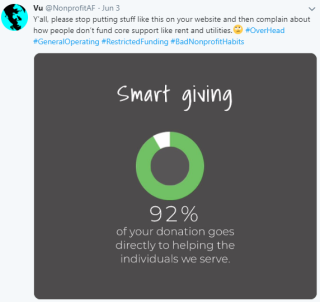A few days ago, nonprofit leader, visionary, and lover of unicorns Vu Le tweeted the message below about one of the top #badnonprofithabits: advertising how high a percentage of a donation goes “directly to helping the individuals we serve.” Vu pointedly pleaded, “Y’all, please stop putting stuff like this on your website and then complain about how people don’t fund core support like rent and utilities.” He is 100% correct!

While it may seem like a good marketing tactic for your nonprofit to get a competitive advantage in the short-term, messages proclaiming unrealistic or unsustainable percentages of dollars that go to program expenses undermines the long-term effectiveness of your organization and of all nonprofits. When it comes to the harmful “overhead myth,” we should be busting the myth, not being complicit in perpetuating it.
All nonprofits need to compute the amount of and recognize the irreplaceable value that “overhead” or “indirect” or “admin” costs have on advancing our missions – and communicate that to our donors. Without effective, updated, and secure database software, mental health nonprofits wouldn’t be able to properly manage the cases of people who come to them for help – not to mention that those people might not come to them if that database were breached because the software was out-of-date. Or, in the truest sense of overhead, what about a domestic violence shelter with a leaky roof? What’s more important: keeping an overhead ratio painfully low or being able to put a roof over the heads of people needing safe shelter?
We all know that infrastructure isn’t a luxury. Connect the dots for your donors and board members and celebrate with them that their gifts supporting infrastructure may seem mundane but, in fact, enable your nonprofit’s employees to be more efficient, effective, and energized when working to advance your nonprofit’s mission. These investments do more for your organization’s sustainability than cutting back on needed investments in order to meet an artificial standard that may bring in just a couple more donations.
At the end of the day, every penny donated is going to advance the mission of the organization, whether it’s being used to prepare a meal or on pens, pencils, and paper. Let’s not let ourselves be defined by flawed metrics. Change the conversation. When you are asked about your overhead ratio, respond by demonstrating your impact and include an anecdote about how some of those overhead costs are a part of that. Show how those infrastructure investments increase your nonprofit’s impact.
Thanks, Vu, for calling this out on Twitter. And thanks to the many nonprofits out there that have already been rejecting this outdated and harmful standard. Only with true transparency about what it costs to effectively run a nonprofit can we all be successful.
